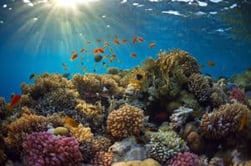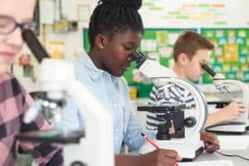Thermal Energy Transfer Inquiry Lab
Middle School Inquiry Lab on Thermal Energy Transfer
In this lab students will observe how thermal energy is transferred from one medium to another.
Each inquiry lab will contain an essential question that will drive the lesson and make students think. For this lesson, the essential question is:
- How can engineers prevent the transfer of thermal energy?
BACKGROUND INFORMATION AND MATERIALS LIST:
Students will begin the lab by reading the essential question and background information. This can be done individually, as lab groups, or as a whole class. If you consider lab groups, you also might include some type of whole class formative checks before digging into the lab.

Materials List:
- thermometer
- 2 metal cans (e.g., vegetable/fruit cans) with or without lids; make sure there are no sharp edges
- cotton balls
- rubber bands (various sizes and thickness)
- fabric pieces (various types: cotton, wool, satin, nylon, socks, etc.)
- paper (construction, printer, cardstock, tissue, etc.)
- 500 mL ice water
PROCEDURE:
For this lab, you can ask your staff or students for donations of various items. You will need to have a control can with which students will compare their data. The first thing students will do is look over all the items that are available for use. Students will have to design a sketch and show you before they move on to the build phase of the lab.
After students have had their designed approved by you, students will start to put things together, but the catch is that you are going to set up a budget for them to stick to. Each item that is for use will have a set dollar amount and students will have to try to construct a thermos that can keep drinks cold longer and under a certain budget.
When the thermos is complete, students will test their creation by placing ice water in their device. Using another container with the same amount of ice water, students will compare temperatures during the 20-minute time period to see if their design works. Students will also graph the temperature data in comparison with each other, device vs. stand alone.
This lab is a great way to incorporate STEM into the science classroom.
CHECK FOR UNDERSTANDING:
At this point in the lab, students will be checked for understanding by answering questions about their findings. Here are a few that come with the lab:
- Give examples of the following terms:
Conduction –
Convection –
Radiation – - Considering the conditions on the island, what type of thermal transfer is the biggest problem for keeping drinks cold? Why?
- What sort of methods or other materials could prevent this form of thermal transfer?
CONCLUSION
Students will go back to the essential question and write a CER (Claim, Evidence, Reasoning) to conclude the lab. Once completed, students will reflect back on their learning by answering the following questions:
- What is the importance of insulators and conductors in this experiment?
- If you repeated your experiment, what would you change to make your device more efficient? Explain.
MODIFIED AND INDEPENDENT INQUIRY VERSIONS
All of the Kesler Science inquiry labs come with three different modification levels. Each lab is differentiated using the icons below.
STANDARDS ALIGNMENT
NGSS: MS-PS3-3 – Apply scientific principles to design, construct, and test a device that either minimizes or maximizes thermal energy transfer.

Download Over $100 in FREE Resources
For Middle School Science
Simply create a login below and gain immediate access to a selection of our Kesler Science product line worth $100 - for FREE. There's a full version of every product type! You'll also join tens of thousands of middle school science teachers who receive timely tips and strategies straight to their inbox.





